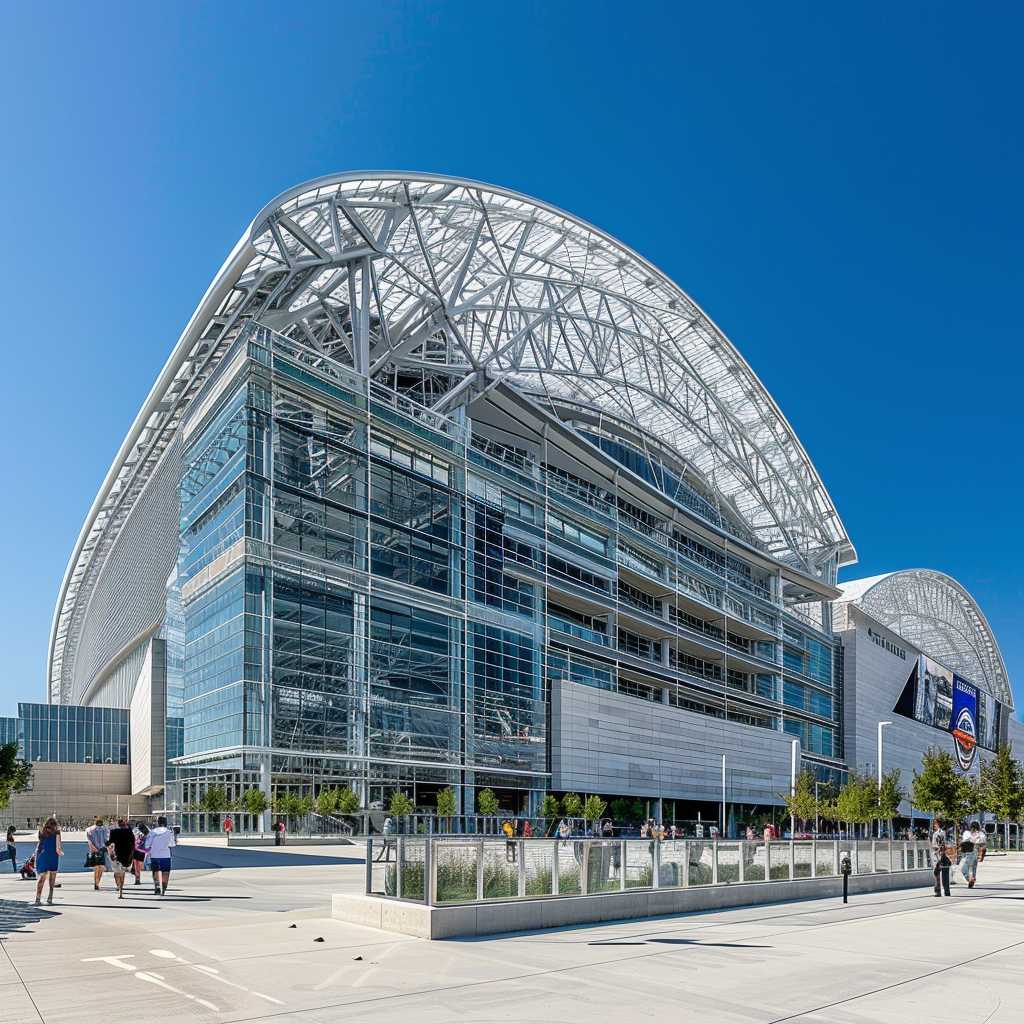The Architectural Marvel and Sports Haven: AT&T Stadium
AT&T Stadium, situated in Arlington, Texas, is a renowned feat of modern engineering and architecture that serves as the home of the Dallas Cowboys, one of the most storied franchises in the National Football League (NFL). Since its opening in 2009, this stadium has set benchmarks for future sports facilities, transcending its role as merely a venue for football games to become a cultural landmark offering multifaceted experiences that range from sports and entertainment to art.
History and Construction of AT&T Stadium
The AT&T Stadium, formerly known as Cowboys Stadium, was conceived as a groundbreaking project that would reflect the ambition and innovative spirit of the Cowboys’ organization. The concept originated from the team’s owner, Jerry Jones, who envisioned a stadium that would be a centerpiece for sports and entertainment in the region. Designed by the architectural firm HKS, construction took place from September 2005 to May 2009 with an emphasis on state-of-the-art technology and luxurious amenities.
This $1.15 billion project was jointly funded by the City of Arlington and the Dallas Cowboys. Taxpayers approved an increase in sales taxes, hotel occupancy taxes and car rental taxes to contribute to the venue’s funding, while Jerry Jones covered any cost overruns. As part of its inaugural celebration, the stadium hosted a concert featuring country music star George Strait.
Design and Features of AT&T Stadium
The design of AT&T Stadium is heavily characterized by its futuristic style. It boasts one of the world’s largest high-definition screens that run from one 20-yard line to the other, offering an immersive viewing experience for fans inside the venue. The retractable roof and walls modify the stadium’s capacity, functionality, and atmosphere depending on the event.
The facility can accommodate up to 100,000 visitors with its expandable seating arrangement, which includes both general admission seating and luxurious suites. Its column-free interior provides unobstructed sightlines to the field or stage from every seat in the house. Not merely limited to football, AT&T Stadium has been utilized for basketball tournaments, soccer matches, boxing matches, concerts, and even rodeos due to its versatile structure.
Cultural Impact and Usage of AT&T Stadium
Beyond hosting sports events, AT&T Stadium is also renowned for its extensive collection of contemporary art which adorns its halls and concourses. This focus on aesthetic enrichment creates a museum-like atmosphere that enhances the game day experience for guests.
As a premier venue in North America, it has continually attracted high-profile events such as Super Bowl XLV, the annual Cotton Bowl Classic, as well as international soccer games. Additionally, artists such as U2, Taylor Swift, and Beyoncé have performed before sell-out crowds within its bounds.
AT&T Stadium is not only significant for entertainment but also for local economy, contributing significantly to job creation and tourism. Arlington and surrounding areas have experienced economic boosts from visitors who travel specifically to view or attend events at this spectacular venue.
Technological Advancements at AT&T Stadium
Incorporation of frontier technology is another aspect where AT&T Stadium stands tall. It has pioneered developments that have since become coveted among new sports venues globally. Features include mobile ticketing services, interactive fan ways inside the arena to engage visitors with live content or games via touchscreens.
Emphasis has also been placed on connectivity; catering to a generation attuned to social media engagement through a robust Wi-Fi network throughout the stadium allowing fans to keep up with social media updates continuously without interruption during events.
The stadium went cashless in 2020 enhancing safety measures at all points of sale and accelerating transaction times for food services, merchandise shops amongst other things; embracing technology means enhanced fan experience.
Environmental Initiatives at AT&T Stadium
Amidst embracing luxurious features and vast technological efficiencies, AT&T Stadium has not ignored its environmental responsibilities. It implements various sustainability practices including energy-saving initiatives such as the use of natural light through extensive use of glass walls and Sky Mirror by Anish Kapoor reflecting Texas’s striking sky presenting unique blend of athletic high performance and artistic expression.
Furthermore recycling programs run throughout events reduces impact on landfill resources effectively turning environmental stewardship into another key highlight attendees can take pride while enjoying their time there.
